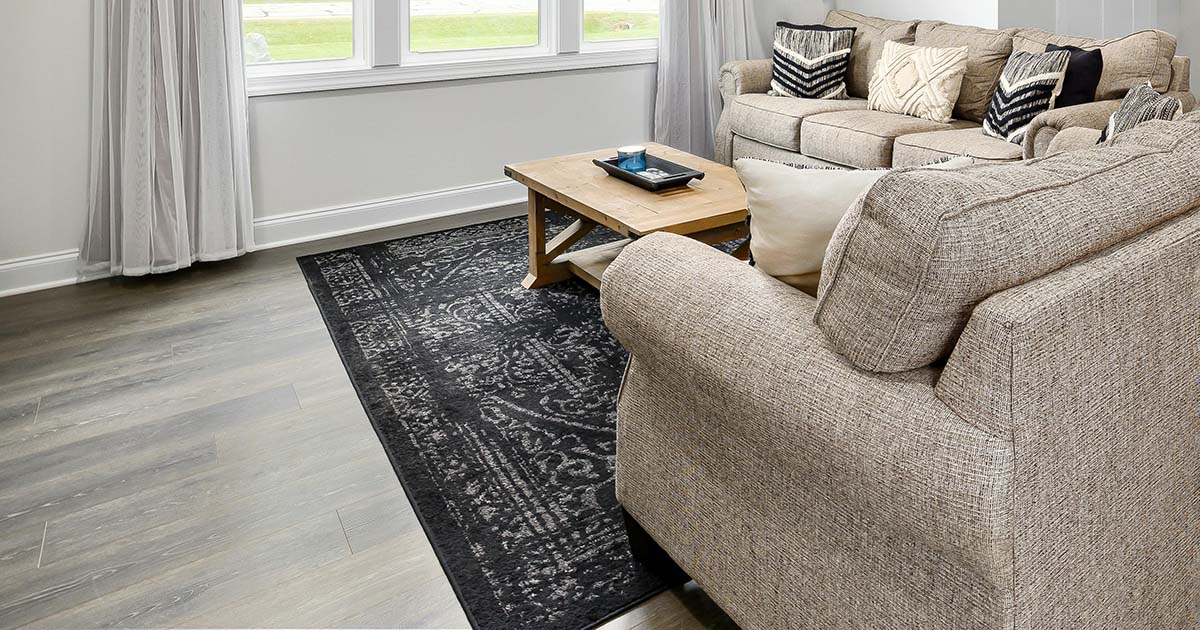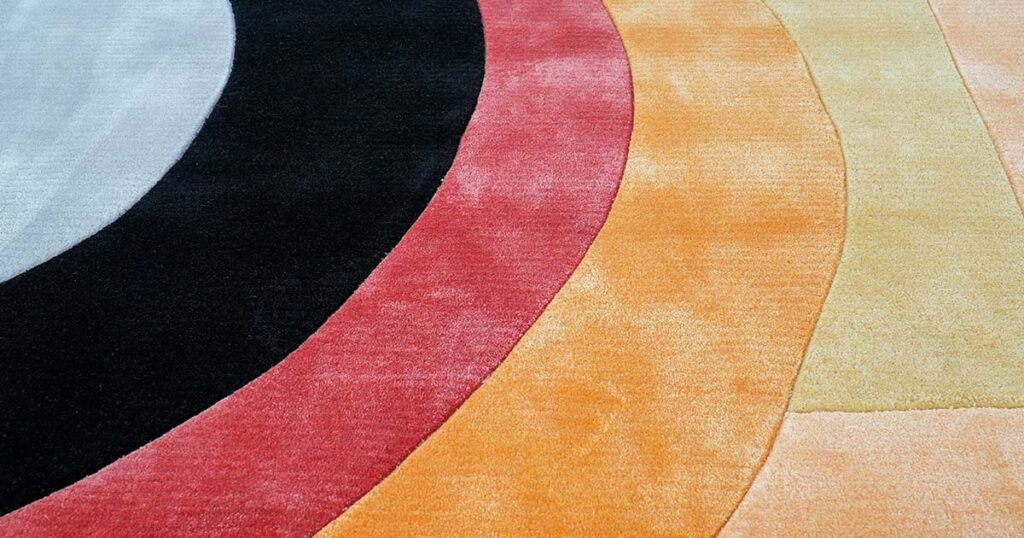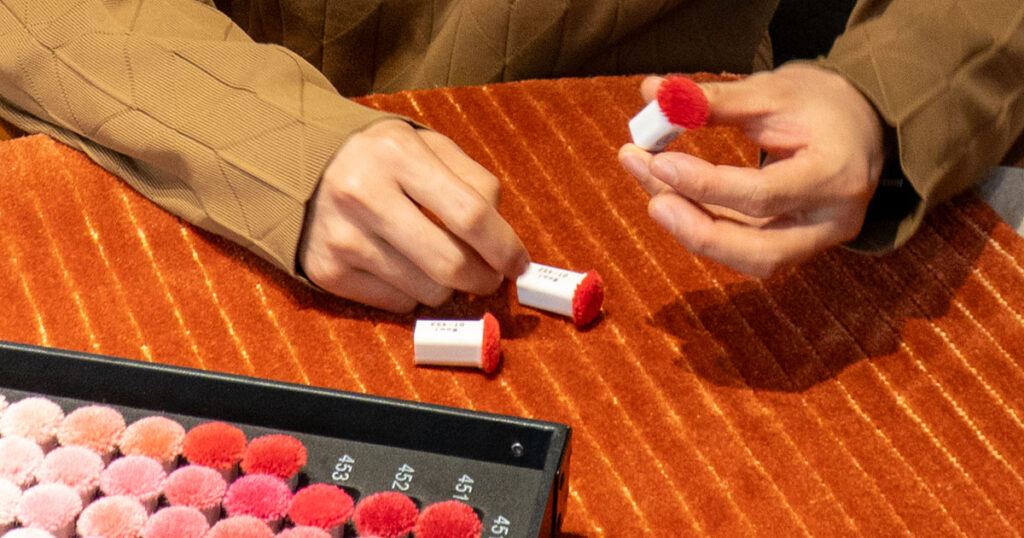Black rugs are more versatile than you might think.
Far from making spaces feel smaller or darker, these bold floor coverings can transform a room when used correctly.
They add sophistication, ground your space, and make other colors pop.
Whether you’re aiming for modern minimalism or cozy elegance, understanding the nuances of black rugs can elevate your interior design game.
This guide explores everything from different black shades to perfect color pairings—helping you confidently incorporate this classic design element into your home.
Common Shades of Black Rugs and Their Differences
Not all black rugs look the same. Subtle undertones create various shades that change how a room feels. Here are the most common black shades used in rugs:
Jet Black
This is the deepest, purest black with no undertones. It makes a bold statement, creates stark contrast, and commands attention. Perfect for modern spaces or when you want high-end drama in your decor.
Charcoal Black
It has a hint of gray, offering sophistication without jet black’s harshness. It creates a cozy, inviting atmosphere while still grounding your space. Charcoal rugs transition easily between formal and casual settings.
Ebony Black
It contains warm undertones – often a very dark brown or olive cast. Under bright light, you might notice a faint brownish hue. This warmth gives ebony elegance and depth, making it feel slightly softer or more “aged.” Ebony works beautifully with traditional or vintage-inspired designs.
Anthracite
It is named after coal and appears as a very deep black with little visible gray or brown. It looks almost “true black” but often has a matte, powdery finish. Anthracite adds drama and sophistication to contemporary spaces, blending with dark furniture or providing a solid backdrop for lighter accents.
Onyx Black
It is inspired by the gemstone. It’s a bold black with slightly cool or gray undertones that add depth and stone-like richness. Onyx pairs well with white or light furnishings for a timeless black-and-white contrast.
Other Off-Blacks
They include variations like Midnight Black (with blue undertones for a sleek, modern feel), Slate Black or Graphite (very dark gray-black with a chalky tone). Some blacks have green or taupe hints that become more apparent when paired with complementary colors.
When designing, match undertones with your existing elements. Warm wood tones work well with ebony (warm-black), while sleek steel-and-glass spaces pair better with jet or midnight black. Remember that surrounding colors highlight undertones – a black rug with brown hints will show more warmth near other browns or beiges.
Symbolic Meanings and Psychology of Black in Interiors
Color psychology affects how we experience a room.
Black carries strong symbolism and emotional effects in interior design:
Elegance and Sophistication
Black equals luxury, formality, and chic style. It brings strength, authority, and elegance to a room. A black rug instantly adds sophistication—think of a grand piano or limousine in gleaming black. Designers often use black touches to “anchor” a space, signaling weight and seriousness in the color scheme.
Mystery and Drama
Black adds depth and mystery. A dark floor creates contrast that makes spaces feel more intimate and intriguing. Black’s link to night and shadows gives it dramatic appeal. A black area rug grounds a room and draws the eye, working like a stage that spotlights the furniture or art on it.
Power and Boldness
Black symbolizes power and authority (think business suits or judge’s robes). Using a large black rug signals confidence and makes a statement that your space is modern, sleek, and unafraid of strong looks. This is why black is popular in contemporary upscale designs and trendy boutiques.
Intimacy and Coziness
While black can be grand, it can also make spaces feel more contained. A black rug absorbs light, making large rooms feel smaller—but in a positive way, often described as “cozier” or more intimate. For instance, a spacious living room with high ceilings might use a broad black rug to create a more inviting seating area.
Somber or Oppressive (if overused)
Too much black or poorly balanced use can trigger negative feelings. If a room has excessive black without enough light or contrasting colors, it can feel gloomy or heavy. Black can sometimes stir feelings of sadness if it dominates. Balance is key—a black rug should be part of a considered palette, not the only color in a room.
Shade-specific nuances
Different black shades influence mood subtly. Charcoal gray-black feels more relaxed and can be calming as well as sophisticated. A warm black (with brown/red undertones) feels more inviting than a cool blue-black which appears crisper and more modern. A charcoal rug could make a den feel comforting, while a jet black rug might feel more formal in the same room.
In summary, black in interiors has a dual nature—classic yet bold, cozy yet dramatic. A black rug taps into these qualities, elevating a room’s sophistication and creating an intimate vibe. Black “anchors” a design, giving it structure, but needs complementary elements (light, color, or texture) to avoid an overly dark mood. When balanced well, a black rug makes a room feel polished, intriguing, and cohesive.
Black Rugs in Combination with Other Colors
As a neutral, black pairs with almost any color. Different combinations drastically change your space’s look and feel. Here’s how black rugs work with various colors:
High-Contrast Pairings (Black + White & Light Neutrals)
The classic black and white combo is timeless and bold. A black rug against white walls or furniture creates striking contrast popular in modern and minimalist designs. Black makes light colors appear cleaner and more vivid—a black rug under a white sofa makes the sofa pop. Light neutrals like cream, beige, or light gray also complement black beautifully, softening the contrast. Use softer whites or creams with black to maintain sophistication without harshness. This combination feels modern, clean, and balanced—light colors prevent black from overwhelming the space, while black adds depth so light colors don’t feel bland.
Black with Gray and Other “Off-Blacks”
Pairing a black rug with gray elements creates a layered monochromatic look. Different gray shades alongside black produce a sophisticated, tonal palette common in contemporary interiors. A charcoal rug with lighter gray furniture and pale gray walls looks refined, adding depth through varying intensities. Ensure some contrast exists so pieces don’t blend together too much. Adding white, metal, or wood accents can break up monotony and add warmth if needed.
Black with Warm Earth Tones (Brown, Tan, Gold)
Earthy colors work wonderfully with black by adding warmth. Pairing black with natural wood tones or warm metals is often the designer’s secret to a sophisticated, balanced look. Wood furniture or a tan leather couch softens a black rug’s boldness, creating a welcoming ambiance. Gold or brass accents with a black rug inject luxury and warmth—the gold seems to “glow” against the black backdrop. This classic combination works for glamour and Art Deco-inspired themes. Black with browns, beiges, or gold feels rich and inviting. The black grounds those warm hues so they don’t feel too rustic, while warm tones prevent black from feeling too cold. Many designers note that wood tones especially “work best with black and feel the most sophisticated.”
Black with Cool Colors (Blue, Green, Teal)
Black can pair with cooler hues, but adjust intensity carefully. Deep navy blue or dark green alongside black can look muddy if too similar in darkness. Designers often advise against mixing black with other very dark colors in large areas because they “compete to do the same job” of anchoring the space.
However, black with medium or light cool colors works beautifully. A pastel blue wall or sage-green sofa gains sophistication with a black rug. The black adds contrast highlighting the gentle color, while blue/green brings a calming vibe that softens black’s starkness. Bright cool colors like turquoise or emerald green “pop” against black as vibrant accents. Black recedes and makes bright colors stand out more, creating dramatic, energetic touches in an otherwise monochrome scheme. Black with cooler colors feels modern and fresh when the cool color is light or bright, but moody and introspective when the cool color is also dark.
Black with Bright & Saturated Colors
Using intense hues (red, hot pink, orange, yellow, purple) with black creates high-energy, high-contrast style. Some combinations have strong cultural associations—black and orange suggests Halloween, while black and yellow can evoke bumblebees. Hot pink and black can feel dated or harsh. Small doses of bright colors against black can work as playful accents, like a single red pillow on a black rug. If you love bright colors, use black as a backdrop to make them pop, but include intermediate tones to bridge the gap. A black-and-white patterned rug could handle a bright yellow throw because the white softens the jump between black and yellow. Many designers recommend limiting super-bright accents in a predominantly black-and-neutral room, or using slightly toned-down versions for a sophisticated look.
Avoiding Clashes
With black, true “clashes” relate more to intensity and balance than color mismatches. Avoid pairing black with very dark colors in large areas—they can blend awkwardly or make a room too dark. If you love navy blue or deep purple, let one color lead (black rug OR navy walls, not both dominant). Black with large amounts of bright primary colors can feel cartoonish unless skillfully executed. Almost any color can work with black if you consider proportion and context. The rule is: ensure contrast or intentional blending. If walls are very dark, choose a patterned black rug with lighter tones. If your decor has many bold, bright pieces, a solid black rug can ground the chaos and prevent clashing.
Contrast, Depth, Warmth, Mood – Putting it Together
A black rug adds contrast and depth through its darkness. Pair black with sufficient lighter elements to create dimension (light walls, metallic accents, vibrant art). This ensures the room doesn’t become one dark spot—instead, the black rug becomes a platform making other colors and furniture stand out. For warmth with a black rug, add warm-toned colors (beiges, terracotta, soft reds, golds) or warm materials (wood, brass, woven textures). For a cooler, modern vibe, pair with whites, steels, or cool blues—but introduce texture (soft throws, plants) to avoid coldness. A black rug enhances mood: in dimly lit rooms with deep wall colors, it creates a lounge-like, intimate feel perfect for home theaters or cozy dens.
For bright, energetic spaces, balance with light-reflecting surfaces (mirrors, glass, lighter hues) and cheerful color pops. Black is “surprisingly versatile” but it’s all about proportions and balance. Small amounts add definition; large areas add drama and intimacy.
By choosing colors around your black rug thoughtfully, you control whether the room feels warm or cool, tranquil or bold, cozy or spacious.
Make It Uniquely Yours
Can’t find the perfect black rug?
We offer custom options in every shade from jet black to charcoal.
Choose your size, texture, and pattern—or add accent colors to match your décor.
Contact us today to create your custom black rug or browse our collection for immediate inspiration!




